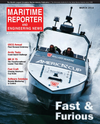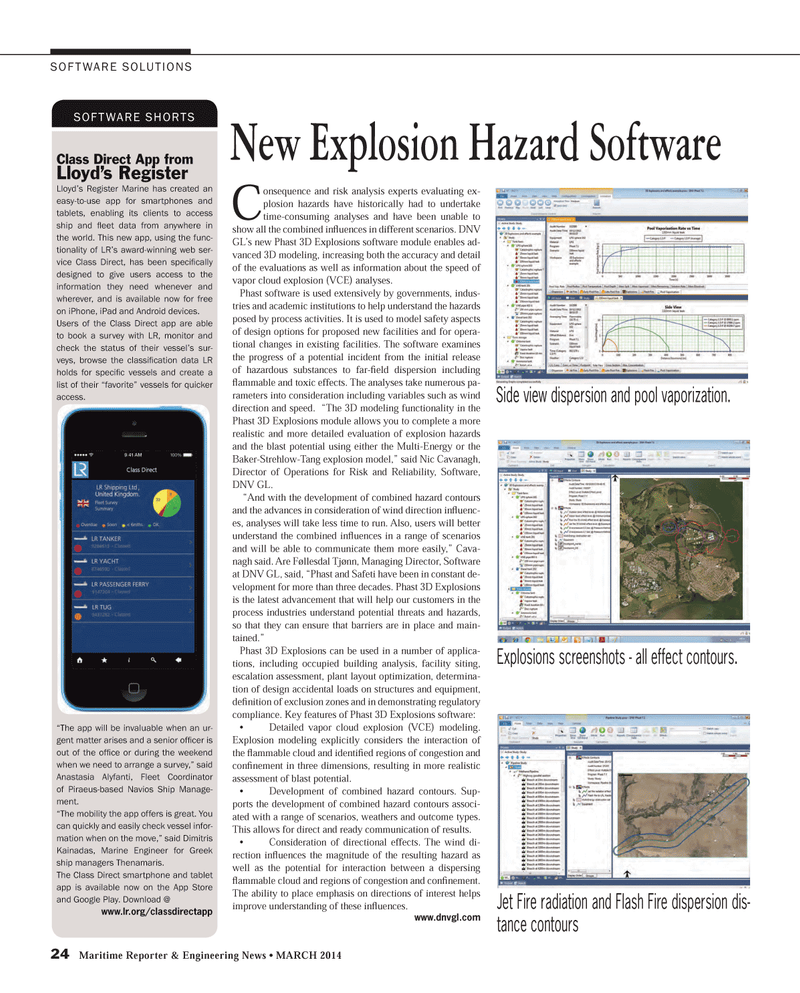
Page 24: of Maritime Reporter Magazine (March 2014)
U.S. Coast Guard Annual
Read this page in Pdf, Flash or Html5 edition of March 2014 Maritime Reporter Magazine
24 Maritime Reporter & Engineering News • MARCH 2014
SOFTWARE SOLUTIONS
Class Direct App from
Lloyd’s Register
Lloyd’s Register Marine has created an easy-to-use app for smartphones and tablets, enabling its clients to access ship and fl eet data from anywhere in the world. This new app, using the func- tionality of LR’s award-winning web ser- vice Class Direct, has been specifi cally designed to give users access to the information they need whenever and wherever, and is available now for free on iPhone, iPad and Android devices.
Users of the Class Direct app are able to book a survey with LR, monitor and check the status of their vessel’s sur- veys, browse the classifi cation data LR holds for specifi c vessels and create a list of their “favorite” vessels for quicker access. “The app will be invaluable when an ur- gent matter arises and a senior offi cer is out of the offi ce or during the weekend when we need to arrange a survey,” said
Anastasia Alyfanti, Fleet Coordinator of Piraeus-based Navios Ship Manage- ment. “The mobility the app offers is great. You can quickly and easily check vessel infor- mation when on the move,” said Dimitris
Kainadas, Marine Engineer for Greek ship managers Thenamaris.
The Class Direct smartphone and tablet app is available now on the App Store and Google Play. Download @ www.lr.org/classdirectapp
SOFTWARE SHORTS
C onsequence and risk analysis experts evaluating ex- plosion hazards have historically had to undertake time-consuming analyses and have been unable to show all the combined infl uences in different scenarios. DNV
GL’s new Phast 3D Explosions software module enables ad- vanced 3D modeling, increasing both the accuracy and detail of the evaluations as well as information about the speed of vapor cloud explosion (VCE) analyses.
Phast software is used extensively by governments, indus- tries and academic institutions to help understand the hazards posed by process activities. It is used to model safety aspects of design options for proposed new facilities and for opera- tional changes in existing facilities. The software examines the progress of a potential incident from the initial release of hazardous substances to far-fi eld dispersion including fl ammable and toxic effects. The analyses take numerous pa- rameters into consideration including variables such as wind direction and speed. “The 3D modeling functionality in the
Phast 3D Explosions module allows you to complete a more realistic and more detailed evaluation of explosion hazards and the blast potential using either the Multi-Energy or the
Baker-Strehlow-Tang explosion model,” said Nic Cavanagh,
Director of Operations for Risk and Reliability, Software,
DNV GL. “And with the development of combined hazard contours and the advances in consideration of wind direction infl uenc- es, analyses will take less time to run. Also, users will better understand the combined infl uences in a range of scenarios and will be able to communicate them more easily,” Cava- nagh said. Are Føllesdal Tjønn, Managing Director, Software at DNV GL, said, “Phast and Safeti have been in constant de- velopment for more than three decades. Phast 3D Explosions is the latest advancement that will help our customers in the process industries understand potential threats and hazards, so that they can ensure that barriers are in place and main- tained.”
Phast 3D Explosions can be used in a number of applica- tions, including occupied building analysis, facility siting, escalation assessment, plant layout optimization, determina- tion of design accidental loads on structures and equipment, defi nition of exclusion zones and in demonstrating regulatory compliance. Key features of Phast 3D Explosions software: • Detailed vapor cloud explosion (VCE) modeling.
Explosion modeling explicitly considers the interaction of the fl ammable cloud and identifi ed regions of congestion and confi nement in three dimensions, resulting in more realistic assessment of blast potential. • Development of combined hazard contours. Sup- ports the development of combined hazard contours associ- ated with a range of scenarios, weathers and outcome types.
This allows for direct and ready communication of results. • Consideration of directional effects. The wind di- rection infl uences the magnitude of the resulting hazard as well as the potential for interaction between a dispersing fl ammable cloud and regions of congestion and confi nement.
The ability to place emphasis on directions of interest helps improve understanding of these infl uences. www.dnvgl.com
New Explosion Hazard Software
Side view dispersion and pool vaporization.
Explosions screenshots - all effect contours.
Jet Fire radiation and Flash Fire dispersion dis- tance contours
MR #3 (18-25).indd 24 3/4/2014 4:51:29 PM

 23
23

 25
25
